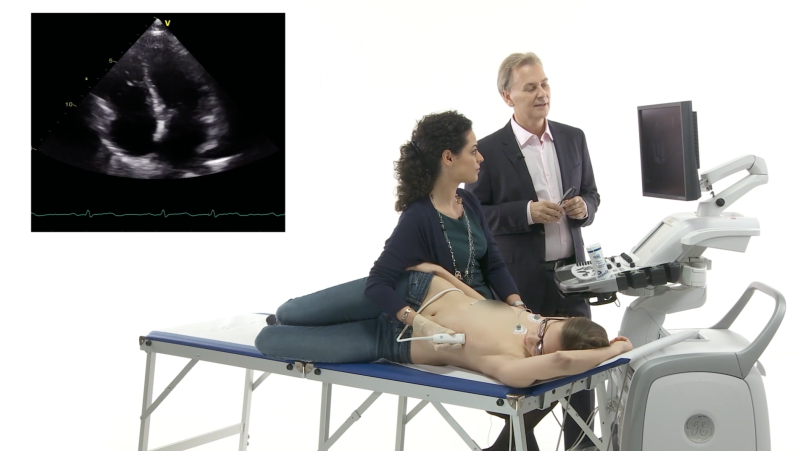Category
Cases
A sin of the past
Scientists once trained a chimpanzee in a cage to hit a lever. As a reward the chimpanzee was given a capsule to eat. The scientists gradually increased the number of times the chimp had to hit the lever to obtain a single capsule. The study was terminated when the chimpanzee was found to hit the lever 12,000 times to receive a single capsule. What was in the capsule? You might have guessed: cocaine. This is the topic for our present case story: drug addiction.
Our patient
Helen was very young - a mere 24 years old - when we met her in our echo lab in March 2014. She told us about her first experience with intravenous heroin at the age of 19. “Bad friends misled her,” she told us. She said it was “a sin of the past” and she was ashamed of it. She deeply regretted her dark past.
A sad story
Addiction had caused her immense trouble. In June 2013 she had been admitted to the hospital with dyspnea, back pain, jugular vein distension, and edema of the lower limbs. A transthoracic echocardiogram (TTE) showed massive tricuspid regurgitation (TR) caused by endocarditis and leaflet perforation. Targeted medical therapy had little effect. Helen’s tricuspid valve was so damaged that surgical valve replacement was the only solution. She received a biological prosthesis.
A new problem
In March 2014 Helen was re-admitted to the hospital with fever (>38°C) and suspected pneumonia. Her jugular veins were distended again. That meant trouble. We were asked to perform a TTE. Helen had been taking no drugs since the day of the operation. She was “clean”. What was the problem now? Take a look yourself:
Apical 4-chamber view. The prosthesis looks “strange”.
One can see the struts of the bioprosthesis.Take a closer look: the prosthesis is covered with a mass.
Parasternal short-axis view. The mass extends to the wall
of the right ventricle and the subvalvular apparatus.
The next right parasternal long-axis view shows how ugly the mass is.
Right parasternal long-axis view: the mass is highly mobile.
This is certainly not a normal prosthesis. The entire valve, including parts of the right atrium and the right ventricle, are covered with fixed and mobile components. What is Helen's problem? The answer is not difficult, given her history of fever and bilateral pneumonia. We also found that her blood cultures were positive for staphylococcus aureus.
The answer
I guess we all agree that Helen has endocarditis of the prosthetic tricuspid valve.The positive blood culture and the softness of the vegetations are indicative of active endocarditis. Septic embolism into the lungs is definitely the cause of bilateral pneumonia.
Sequelae
Helen experienced endocarditis again one year later - this time on the prosthesis. But, why does she have signs of right heart failure? Is it tricuspid regurgitation? To find out we need color Doppler:
Apical 4-chamber view with color Doppler:
there is no tricuspid regurgitation.
Clearly, tricuspid regurgitation is not her problem. Rather strange that the valve is still competent, considering how massive the infection is. There is another clue in the color Doppler study. Did you detect the turbulent inflow signal? Here is a slightly different angulation to help you see the high velocity (candle flame appearance) across the prosthesis.
High-velocity (turbulent) inflow into the prosthesis.
To determine true inflow velocities we need CW Doppler:

Apical 4-chamber view. CW Doppler across the prosthesis.
The mean gradient is 19.8 mmHg
Even in a normal prosthesis we would have some degree of flow acceleration, but a gradient of almost 20 mmHg is extremely high. Helen also has an obstruction of the prosthetic valve, obviously caused by vegetations on the valve.
What’s next?
I'm afraid that there is only one hope for Helen: reoperation. After all she has a very aggressive pathogen (Staphylococcus aureus), uncontrolled infection, prosthetic valve endocarditis, and also hemodynamic compromise.

Join the Ultrasound Party!
30% OFF plus LIFETIME ACCESS.
Offer extended until July 9th, 2021.
Take-home messages
Intravenous drug abuse is the most common cause of right heart endocarditis. The drug has a direct toxic effect on the endothelium. Drugs are known to weaken the immune system. Needle contamination due to poor hygiene does the rest. Prosthetic valves in the setting of drug addiction increase the risk of endocarditis - which is why surgeons try to avoid them. Native valve endocarditis usually causes valve destruction and regurgitation. This is different in prosthetic valve endocarditis, where the infectious masses (vegetations) may also cause obstruction. While this is more common in mechanical valves, Helen's case shows that it may occur in biological valves as well. One thing is clear: mortality is very high in active endocarditis. Therefore, early diagnosis is essential. Given the sheer size of the vegetations, it may be too late to do anything effective for Helen. We cross our fingers and hope Helen need not undergo further punishment for her sins of the past.
We will let you know whether Helen made it or not. In the meantime you can check out our website. Maybe we can make you “echo-addicted” and convince you to sign up for our Masterclass. You will be satisfied…and you won’t be committing a sin!

Best,
Anna-Maria Pistritto


